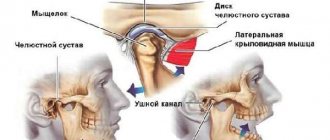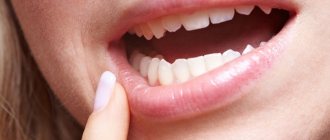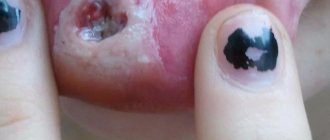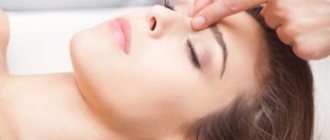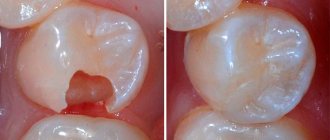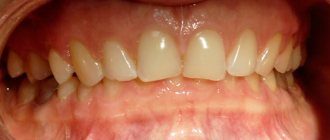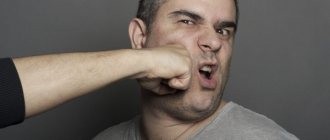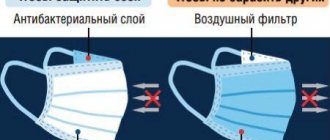What it is
The lower jaw is considered the only movable part of the skull; this functional feature has its drawbacks, the most serious being an increased tendency to injury. Jaw dislocation is a pathology that is accompanied by the movement of its head from its natural anatomical position.
This happens quite often and can happen during the process of chewing and swallowing food.
Structure of the lower jaw
The lower jaw is the only part of the skull that can perform movements, which is the result of thousands of years of human evolution. This opened up new opportunities for our species, but also caused some troubles; due to her high mobility, she became more susceptible to injury, including dislocations. It is impossible to dislocate the upper jaw, it can only be broken, because it is immobile.
The lower jaw bone ends at the temporal joint, which is a depression in the articular-temporal bone. Its high mobility provides us with the opportunity not only to chew food, but also to communicate with each other. The lower jaw can actively move vertically and not so actively horizontally.
Dislocation occurs when the temporomandibular joint is displaced, that is, its head jumps out of the socket. Persistent such injuries may indicate defects in the structure of the joint: either too small pits or very weak ligaments. If the displacement is only partial, then the joint returns to its natural position without much effort; this condition is also called subluxation.
Article on the topic - how to cure lockjaw?
Symptoms
The clinical picture depends on the type of dislocation, which is accompanied by a characteristic click and pain; anterior and posterior dislocations are distinguished; the symptoms in both cases are somewhat different. Anterior dislocation is accompanied by drooping of the jaw and its slight protrusion forward. This article will tell you what gum recession is and the reasons for its occurrence.
It is not possible to close your mouth after this; the pathology is accompanied by profuse salivation, which occurs as a result of the accumulation of saliva in the oral cavity.
General symptoms:
- difficulty opening and closing the mouth;
- skew or protrusion of the jaw forward;
- pain that may radiate to the temple area;
- severe drooling.
- inability to pronounce words normally.
Features depending on the type of injury:
- With a unilateral dislocation, the face becomes asymmetrical, pumped, speech is difficult until it is completely lost.
- With a posterior dislocation, there is a displacement of the lower jaw relative to the upper; a posterior dislocation is dangerous due to a possible fracture of the bone wall of the auditory canal.
- Habitual dislocations occur against the background of old or primary ones; the situation is aggravated by overstretching of the joint capsule and ligaments, as a result of which the stability of the joint is lost. In this case, jaw dislocation occurs even with minor movements.
Diagnosis and treatment of jaw dislocation
Before treating a dislocated jaw, it is necessary to distinguish it from similar diseases by its characteristic symptoms. Therefore, before reducing a dislocated mandible, doctors almost always carry out minimal diagnostics:
- study medical history;
- collect and analyze the patient's medical history;
- interview the patient's relatives;
- carry out a physical examination and palpation of the damaged area;
- They use instrumental diagnostic methods: radiographic studies, MRI, CT.
Sometimes diagnosis consists only of a visual examination of the patient, after which the traumatologist inserts the jaw joint into place.
What kind of doctor sets the jaw?
Sometimes patients refuse hospitalization and try to insert the dislocated articular head into the fossa at home - such actions can lead to serious complications.
If you do not want to go to the hospital, you should come to a regular clinic. The therapist on duty will tell you which doctor to go to if you have a dislocated jaw, based on the patient’s condition and concomitant diseases. Usually victims are referred to a surgeon or traumatologist , but in special cases the therapist can straighten the dislocated jaw on his own. If the damage is minor, the adjustment will take just a few minutes.
Treatment methods
There are several methods of jaw realignment used by medical professionals:
- Hippocratic method. Most often, the jaw joint is displaced with its help.
- Popescu method. It is used only for the treatment of old injuries of the jaw apparatus.
- Blechman-Gershuny method.
To restore joint function, special prostheses are used for temporary or permanent wear. Most often, for the purpose of reposition (reduction), patients are fitted with a Petrosov apparatus, since it is convenient for daily use and is inexpensive.
Muscle relaxants
When treating mandibular dislocation in a medical institution, the patient is given special muscle relaxants - medications that help relax striated muscles and reduce muscle tone. Thanks to these medications, the joint is reduced without disturbing the structure of the soft tissues.
Muscle relaxants have an anesthetic effect, so adjusting the jaw in the clinic does not hurt at all . But these drugs must be administered with caution due to the large number of side effects and contraindications.
Lack of proper anesthesia is one of the reasons why it is not recommended to try to put the jaw back into place yourself. When carried out at home, this process will be unpleasant, painful and lengthy, although usually the jaw joint is inserted quickly.
Causes
Jaw injury can occur due to any external impact or sudden movement; pathology can also occur for the following reasons:
- heavy chewing;
- singing, laughing, screaming, normal conversation;
- biting off large pieces, putting large objects into the mouth;
- gastric probing;
- epileptic seizures;
- specific structure of the joint;
- dysfunction of the endocrine system;
- some infectious diseases;
- joint diseases, leading to weakening of ligament tissues, reduction in the height and shape of joints;
- improper prosthetics, malocclusion;
- various injuries;
- taking an x-ray of the oral cavity;
- gag reflexes;
- asymmetry of the lower jaw;
- epilepsy attacks;
- removal of foreign bodies from the respiratory tract;
- rough dental operations;
- gastric probing;
- endotracheal anesthesia.
Most often, athletes suffer from jaw dislocation, in most cases boxers.
It is worth noting that jaw dislocation is most often diagnosed among women, since they physiologically have a smaller joint structure. It is not recommended to try to straighten the jaw yourself, since without certain knowledge and skills it is almost impossible to do it correctly.
The only thing the patient can do before the specialist arrives is to bandage the chin with a towel or scarf to fix the position and protect against possible damage to the soft tissues. Applying ice will help relieve pain. This link will tell you what to do if the gum above the tooth hurts when you press it.
First aid
If you have dislocated your jaw, you should not make sudden movements, as they can lead to a deterioration in your health. In case of severe pain, it is recommended to take any analgesic, but only if you are sure that you are not allergic to its components. With this pathology, there is already an increase in blood pressure and difficulty breathing, and an allergic reaction to an unfamiliar drug will only worsen the condition.
Then you need:
- Fix the knocked-out jaw in one position with a bandage made from available materials (as with any other sprain) to prevent it from moving even further.
- Make something like a gag out of absorbent fabric to remove excess saliva.
- Call an ambulance. If you are unable to speak on your own, you should ask neighbors, passers-by, or employees of nearby stores to call an ambulance if the injury occurred on the street. If there is a hospital nearby, it is better to go straight to the emergency room of a medical institution.
It is not recommended to speak if the jaw apparatus is injured , since any movements of the mouth will be painful. Trying to straighten your jaw at home without proper practice is also not worth it.
Self-treatment of a jaw dislocation, even if it occurs during normal yawning, can lead to long-term joint dysfunction and damage to the setter's fingers.
Displacement classifications
Dislocations are classified according to certain criteria:
- Unilateral - the head of the joint moves out of its normal position, the mouth opens, and the jaw moves to the healthy side.
- Bilateral - considered the most common, the mouth is completely open, the jaw is pushed forward;
- Complete - the articular surfaces do not touch.
- Incomplete (subluxation) – there is partial contact of the joints; if the soft tissue is ruptured, it is considered complicated.
- Habitual – diagnosed when a dislocation occurs with light pressure on the jaw or chewing, this is the only way when you can correct it yourself; surgical intervention will help prevent further displacement. As part of its implementation, an increase in the depth of the cavity or the height of the tubercle is provided, and the joint capsule is also strengthened. Sometimes additional support is created, which ensures its fixation in the desired position.
- Posterior – the main cause is considered to be a blow to the chin, as a result of which the jaw moves back. Such a dislocation is the most dangerous, as it leads to rupture of the capsule and damage to bone tissue, which leads to ear bleeding.
Clinical picture of the pathology
Symptoms depend on the type of injury the patient received. So, the anterior displacement manifests itself as follows:
- pain syndrome in the parotid area,
- the mouth is in an open position, any attempts to close it are unsuccessful,
- there is no opportunity to talk,
- saliva is produced profusely,
- facial proportions are disturbed.
If the dislocation is posterior, then in addition to sharp pain in the area near the ears, there is an inability to open the mouth, the person has difficulty breathing and swallowing saliva. In severe cases, bleeding from the ears is possible.
Signs of complicated jaw dislocations are: severe pain, blood from the ears, hematomas in the parotid area spreading to the face and neck, pronounced swelling in the joint area.
We suggest you read Why does the tongue hurt as if it were burned and how to treat it?
Treatment
Treatment of a dislocated tooth, as with a dislocated jaw, is carried out after diagnosis; the main method is radiography. After this, the jaw is realigned under local anesthesia; this must be done by a specialist; the jaw must be fixed. The patient must wear a tight immobilizing bandage, which ensures that the jaw remains motionless for 1-2 weeks. During this time, you should adhere to a diet; solid foods are replaced with cereals and soups.
Reduction of a posterior dislocation is carried out in a similar way; the thumbs must be placed behind the wisdom teeth. After the procedure, a bandage is also applied to the jaw for several weeks. To correct ordinary dislocations, surgical operations are used; if they are caused by other diseases, they must be cured.
Never adjust your jaw yourself. Only a specialist should carry out such manipulations.
Correction of old displacements is carried out under local or general anesthesia; you have to wear a fixing bandage or orthopedic devices for up to 3 weeks. The outcome in the vast majority of cases is favorable; in difficult situations, surgery may be required, after which there is still the possibility of difficulties in the lower jaw. This material will tell you what dental edentia is.
During the recovery period, it is not recommended to open your mouth wide, scream, or suppress yawning; habitual dislocation can be caused by a large amount of food in the mouth; it is recommended to eat slowly, biting off small pieces.
Hippocratic method
Before performing the procedure, the doctor wraps his thumbs with a towel or gauze bandage and approaches the patient sitting on a chair. The specialist places his fingers on top of the chewing teeth and clasps the rest of the lower part of the jaw. With the upper fingers he presses the jaw down, with the remaining fingers he presses the chin upward. Read about pathological tooth wear here.
Immediately after this, the jaw must be moved back and raised up; restoration of the original state is indicated by a characteristic click. Immediately after this, an involuntary closure of the jaw occurs. The fabric protects fingers from accidental damage during manipulation.
Blechman-Gershuny method
There are 2 options for the procedure:
- The doctor places his fingers in the oral cavity , gropes the limbs of the joint, and presses the jaw simultaneously back and down. The return of the joint is indicated by a characteristic click.
- The doctor feels with his fingers the ends of the affected joint from the outside, after which he performs the same manipulations. This method is considered more comfortable for doctors and patients.
Popescu method
Recommended for long-standing dislocations with forward displacement; during the procedure, the patient must lie on his back; administration of local anesthesia is indicated. Rollers with a diameter of 2 cm are placed between the teeth and cheek, after which it is necessary to press the jaw back and up. Find out about digital dental orthopantomography here.
The method does not always show effectiveness; if there is no result, surgical intervention using special devices is indicated.
Orthopedic devices for dislocations
For frequently repeated displacements, removable and non-removable structures are used. Removable type designs have become more popular: the Petrosov, Pomerantseva-Urbanskaya, Yadrova, etc. apparatus. Their main task is to prevent the mouth from opening too wide when yawning or while eating. Most often, treatment of a dislocation occurs without complications and in a short time. However, sometimes pain may occur.
Treatment of a dislocation will be much safer if the reduction is performed by a doctor. However, it is not always possible to go to the hospital, so you need to know how to straighten your jaw yourself. This can be done by following certain rules:
- The patient should be seated on a chair with his head leaning against the wall, or if an assistant is available, you should be asked to hold the patient's head. Your hands should be 10 cm below the patient's head.
- The thumbs should be wrapped in a towel or gauze to prevent injury during the reduction process.
- Standing opposite the patient, tell him to open his mouth wide. Place your thumbs on the lateral teeth of the lower jaw, and tightly clasp the lower jaw with the rest.
- Use your thumbs to press your teeth down and back, and use your other fingers to lift your chin up.
- Quickly remove your fingers from the side teeth towards the cheeks. Reduction will be accompanied by a click and closing of the jaws.
- If, with a bilateral displacement, it is not possible to straighten both sides at once, you can straighten each side separately.
- With unilateral displacement, you only need to press on the affected half.
- After the reduction process, the patient is prohibited from yawning widely and opening his mouth too much for 6 weeks. Food must be taken in crushed form.
IMPORTANT! If the displacement cannot be corrected on your own, you must consult a doctor.
Blekhman-Gershunya method
This method is the simplest and fastest, but it requires coordination and care, since it must be performed literally in one movement.
It is used for uncomplicated bilateral dislocations.
- First, the doctor feels the coronoid processes of the jaw bone near the arches of the cheekbones.
- Then, in one movement, the bone moves down and back - until a characteristic click occurs.
The jaw can be adjusted in this way from the inside (the coronoid processes are felt from the inside of the oral cavity) and from the outside. Reduction from the outside is considered an easier method, although it takes some skill to quickly find the coronoid processes.
The Blechman-Gershuny method is recommended for use for regular uncomplicated dislocations caused by ligament weakness or shallow depth of the articular fossa.
